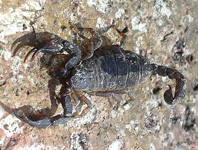Abstract
The fifth species of the genus, Megacormus xichu sp. nov., is described and compared to the other species. An identification key to these species as well as a distributional map with localities taken from the literature are provided.
References
Díaz Nájera, A. (1966) Alacranes de la República Mexicana: Descripción de Megacorus gertschi n. sp. (Scorpionida: Chactidae). Revista del Instituto de Salubridad y Enfermedades Tropicales, 26, 263–276.
Fet, V. & Sissom, W.D. (2000) Family Euscorpiidae Laurie, 1896. In: Fet, V., Sissom, W.D., Lowe, G. & Braunwalder, M.E. (Eds.), Catalog of the Scorpions of the World (1758–1998). The New York Entomological Society, New York, USA, 503–553.
Francke, O.F. (1979) Observations on the reproductive biology and life history of Megacormus gertschi Diaz (Scorpiones, Chactidae, Megacorminae). Journal of Arachnology, 7, 223–230.
González-Santillán, E. (2001) Catálogo de la Colección Nacional de Arácnidos (CNAN). Bachelor’s Thesis, Facultad de Ciencias, Universidad Nacional Autónoma de México, 146 pp.
González-Santillán, E. & Alvarez-Padilla, F. (2015) The male of Megacormus granosus (Gervais, 1844) with comments on its hemispermatophore (Scorpiones, Euscorpiidae). ZooKeys, 504, 75–91.
http://dx.doi.org/10.3897/zookeys.504.9027González-Santillán, E. & Prendini, L. (2013) Redefinition and generic revision of the North American vaejovid scorpion subfamily Syntropinae Kraepelin, 1905, with descriptions of six new genera. Bulletin of the American Museum of Natural History, 382, 1–71.
https://doi.org/10.1206/830.1
Hoffmann, C.C. (1931) Monografías para la entomología médica de México. Monografía número 2, Los escorpiones de México. Primera parte: Diplocentridae, Chactidae, Vaejovidae. Anales del Instituto de Biología Universidad Nacional Autónoma de México, 2, 291–408.
INEGI (2016) Archivo Histórico de Localidades Geoestadísticas. Available from: http://www.inegi.org.mx/geo/contenidos/geoestadistica/consulta_localidades.aspx/ (accessed October 2016)
Loria, S.F. & Prendini, L. (2014) Homology of the Lateral Eyes of Scorpiones: A Six-Ocellus Model. PLoS ONE, 9 e112913.
http://dx.doi.org/10.1371/journal.pone.0112913.
Pocock, R.I. (1900) Some new or little-known neotropical scorpions in the British Museum. Annals and Magazine of the Natural History, 5, 469–478.
http://dx.doi.org/10.1080/00222930008678315.
Pocock, R.I. (1902) Arachnida, Scorpiones, Pedipalpi and Solifigae. In: Godman F.D. & Salvin O. (Eds.), Biologia Centrali-Americana: zoology, botany and archaeology. Porter, R.H., London, UK, pp. 1–71.
Prendini, L., Francke, O.F. & Vignoli, V. (2010) Troglomorphism, trichobothriotaxy and typhlochactid phylogeny (Scorpiones, Chactoidea): More evidence that troglobitism is not an evolutionary dead-end. Cladistics, 26, 117–142.
https://doi.org/10.1111/j.1096-0031.2009.00277.x
QGIS Development Team (2016) QGIS version 2.14.7-Essen. Available from: http://www.qgis.org/ (accessed May 2016)
Sissom, W.D. (1990) Systematics, Biogeography and Paleontology. In: Polis, G.A. (Ed.), The Biology of Scorpions. Stanford University Press. Stanford, California, USA, pp 587.
Sisom, W.D., Polis, G.A. & Watt, D.D. (1990) Field and laboratory methods. In: Polis, G.A. (Ed.), The Biology of Scorpions. Stanford University Press. Stanford, California, USA, pp. 587.
Sissom, W.D. (1994) Systematic studies on the genus Megacormus (Scorpiones, Chactidae, Megacorminae), with descriptions of a new species from Oaxaca, Mexico and of the male of Megacormus segmentatus Pocock. Insecta Mundi, 8, 265–272.
Soleglad, M.E. (1976) Revision of the Scorpion Subfamily Megacorminae (Scorpionida: Chactidae). Wasmann Journal of Biology, 34, 251–303.
Soleglad, M.E. & Fet, V. (2001) Evolution of scorpion orthobothriotaxy: a cladistic approach. Euscorpius, 1, 1–38.
Soleglad, M.E. & Fet, V. (2003) High-level systematics and phylogeny of the extant scorpions (Scorpiones: Orthosterni). Euscorpius, 11, 1–175.
Trujillo, R.E. & Armas, L.F. De. (2012) Nueva especie de Plesiochactas Pocock, 1900 (Scorpiones: Euscorpiidae) de Guatemala. Boletín de la Sociedad Entomológica Aragonesa, 50, 263–266.
UNAM (2016) UNIBIO. Available from: http://unibio.unam.mx/minero/ (accessed October 2016)
Vachon, M. (1974) Étude des caractères utilisés pour classer les familles et les generes de Scorpions (Arachnides). 1 La trichobothriotaxie en arachnologie, sigles trichobothriaux et types de trichobothriotaxie chez les Scorpions. Bulletin de Muséum National d’Historie Naturelle, 140, 857–958.
Vignoli, V. & Prendini, L. (2009) Systematic revision of the troglomorphic North American scorpion family Typhlochactidae (Scorpiones: Chactoidea). Bulletin of the American Museum of Natural History, 326, 1–94.
https://doi.org/10.1206/570.1
Zarate-Galvez, K & Francke, O.F. (2009) Redescription of Plesiochactas mitchelli (Scorpiones: Euscorpiidae): a rare scorpion from Central America. Journal of Arachnology, 37, 338–345.
https://doi.org/10.1636/Ha09-02.1

